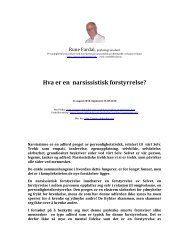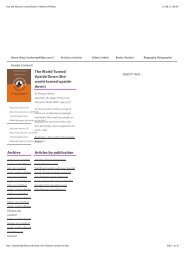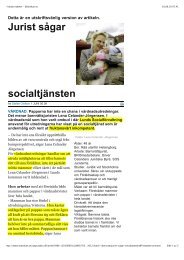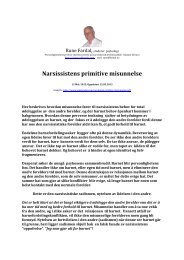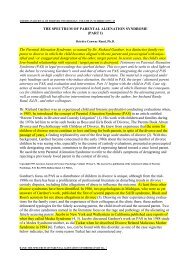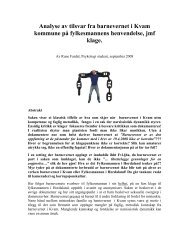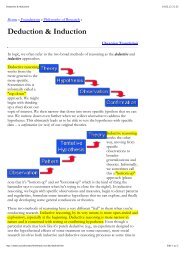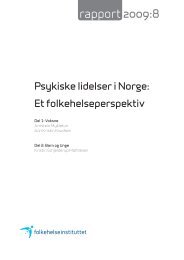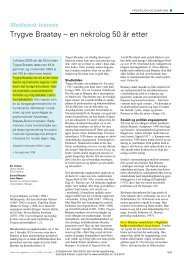The origins of narcissism and narcissistic personality disorder a
The origins of narcissism and narcissistic personality disorder a
The origins of narcissism and narcissistic personality disorder a
You also want an ePaper? Increase the reach of your titles
YUMPU automatically turns print PDFs into web optimized ePapers that Google loves.
THE ORIGINS OF NARCISSISM 63<br />
in humans (Ainsworth et al., 1978). From this base, commentators (eg,<br />
Eagle, 1984; Lichtenberg, 1983; D. K. Silverman, 1986) have challenged,<br />
as noted, two basic assumptions <strong>of</strong> psychoanalytic approaches<br />
to development: (a) that tension reduction is the basic motivational<br />
principle <strong>of</strong> infantile (or human) life <strong>and</strong> (b) that the formation <strong>of</strong><br />
attachments is secondary to the satisfaction <strong>of</strong> oral drives. Instead,<br />
infants are seen as actively seeking <strong>and</strong> requiring an optimal level <strong>of</strong><br />
environmental stimulation, rather than as attempting to reduce it to a<br />
minimum (see, among many others, Emde & Robinson, 1979; Fantz,<br />
1961, 1963; Haith, 1980; Kinney & Kagan, 1976; R<strong>of</strong>fwarg, Muzio, &<br />
Dement, 1966), <strong>and</strong> attachment is itself seen as an autonomous drive,<br />
independent <strong>of</strong> orality. By now, numerous researchers7 regard infants<br />
not only as attached to their caregivers but as active elicitors <strong>and</strong> initiators<br />
<strong>of</strong> interactions with them. Infant-caregiver interaction is thus<br />
increasingly conceptualized as a system <strong>of</strong> mutual regulation that requires<br />
infants, no less than parents, to have highly sophisticated perceptual<br />
<strong>and</strong> communicative abilities. <strong>The</strong>se are abilities that enable an<br />
infant, at age 4 weeks, to differentiate the world <strong>of</strong> human interaction<br />
from that <strong>of</strong> interaction with inanimate objects (Brazelton et al., 1974;<br />
see Trevarthen, 1977) <strong>and</strong>, with the emergence <strong>of</strong> a core self after age<br />
2 months (Stern, 1985), to differentiate playing with mother from playing<br />
with a rattle.<br />
Infant cognitive abilities. Infants during the first 2 months <strong>of</strong> life<br />
show a perceptual preference not only for the human face (Emde &<br />
Robinson, 1979) but specifically for faces that speak (Haith, 1980).<br />
<strong>The</strong>se preferences are unsurprising, given that the human, <strong>and</strong> more<br />
specifically the mother’s, face is the most important stimulus in the<br />
world <strong>of</strong> arrinfant. Still more striking about infants’ cognitive abilities<br />
is the capacity for cross-modal perceptual equivalence (Lewkowicz &<br />
Turkewitz, 1980; Meltz<strong>of</strong>f, 1985; Meltz<strong>of</strong>f & Borton, 1979; Stern, 1985),<br />
the capacity to correlate perceptions, made in different sensory modes<br />
(e.g., auditory <strong>and</strong> visual), <strong>of</strong> the same object. In one experiment (Mel-<br />
For example, Beebe (1986); Beebe <strong>and</strong> Lachmann (1988); Brazelton <strong>and</strong><br />
Als (1979); Brazelton, Koslowski, <strong>and</strong> Main (1974); Cohn <strong>and</strong> Tronick (1988);<br />
Emde (1988); Gianino <strong>and</strong> Tronick (1988); M. Lewis <strong>and</strong> Rosenblum (1974);<br />
S<strong>and</strong>er (1977,1983); Stern (1977,1985); Trevarthen (1977,1979,1984); Tronick<br />
(1989).




